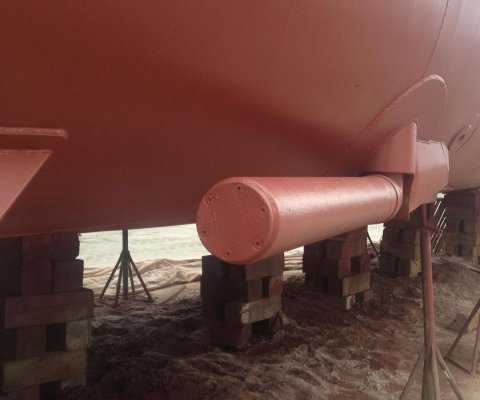I posted the introduction of the "Jetten 50 MPC". As a standard option Jetten Yachts can equip the yacht with the RotorSwing Stabilizer. For who never heard of this system here some info.
RotorSwing "The World's First Retractable Magnus Effect Stabilizer"
RotorSwing is the first fully electrically driven, non-hydraulic roll damping system for yachts up to 30 metres based on the Magnus effect. Instead of traditional fins, the system uses rapidly rotating cylinders which, subject to the direction of rotation, generate an up or downward pressure.
The biggest advantage of RotorSwing in comparison to a fin driven conventional system, is the greater roll damping at lower speeds. To achieve effective roll damping with fins it is necessary to reach a substantial speed through the water. This is partly due to the fact that often, the surface of the fins have been designed to be as small as possible to reduce the risk of damage. In shallow water, protruding fins are, in particular, very vulnerable.
RotorSwing features retractable rotors, eliminating the risk of damage. The retracted rotors remain largely within the turbulent boundary layer1 of the vessel so that any resistance is negligible.
If the rotors are in use in the “Drive” position, they can protrude outside the hull of the ship. However, should the engine be put in to neutral, the rotors automatically retract. This prevents damage during maneuvering and berthing at quays, in locks and ports.
The rotors do not have any effect on the steering and therefore, unlike fin based systems, can be mounted at a position of choice. For the majority of yachts, this is likely to be dictated by the onboard available space for the compact electric motor. It is even possible to mount the rotor at the stern which, in particular for fast-moving yachts, may be preferable.
RotorSwing is the first fully electrically driven, non-hydraulic stabilizing system based on the Magnus effect. No expensive, vulnerable hydraulic pumps, cylinders or high pressure lines and no risk of oil leaks on board. RotorSwing is a product from RotorSwing Marine, founded by Theo Koop. Theo, the founder and owner of the former KoopNautic Holland, is, for good reason, known as “the Godfather of stabilizers”.
Link: RotorSwing
RotorSwing "The World's First Retractable Magnus Effect Stabilizer"
RotorSwing is the first fully electrically driven, non-hydraulic roll damping system for yachts up to 30 metres based on the Magnus effect. Instead of traditional fins, the system uses rapidly rotating cylinders which, subject to the direction of rotation, generate an up or downward pressure.
The biggest advantage of RotorSwing in comparison to a fin driven conventional system, is the greater roll damping at lower speeds. To achieve effective roll damping with fins it is necessary to reach a substantial speed through the water. This is partly due to the fact that often, the surface of the fins have been designed to be as small as possible to reduce the risk of damage. In shallow water, protruding fins are, in particular, very vulnerable.
RotorSwing features retractable rotors, eliminating the risk of damage. The retracted rotors remain largely within the turbulent boundary layer1 of the vessel so that any resistance is negligible.
If the rotors are in use in the “Drive” position, they can protrude outside the hull of the ship. However, should the engine be put in to neutral, the rotors automatically retract. This prevents damage during maneuvering and berthing at quays, in locks and ports.
The rotors do not have any effect on the steering and therefore, unlike fin based systems, can be mounted at a position of choice. For the majority of yachts, this is likely to be dictated by the onboard available space for the compact electric motor. It is even possible to mount the rotor at the stern which, in particular for fast-moving yachts, may be preferable.
RotorSwing is the first fully electrically driven, non-hydraulic stabilizing system based on the Magnus effect. No expensive, vulnerable hydraulic pumps, cylinders or high pressure lines and no risk of oil leaks on board. RotorSwing is a product from RotorSwing Marine, founded by Theo Koop. Theo, the founder and owner of the former KoopNautic Holland, is, for good reason, known as “the Godfather of stabilizers”.
Link: RotorSwing
[youtube]0dxNaS8p1rI[/youtube]
Last edited:




